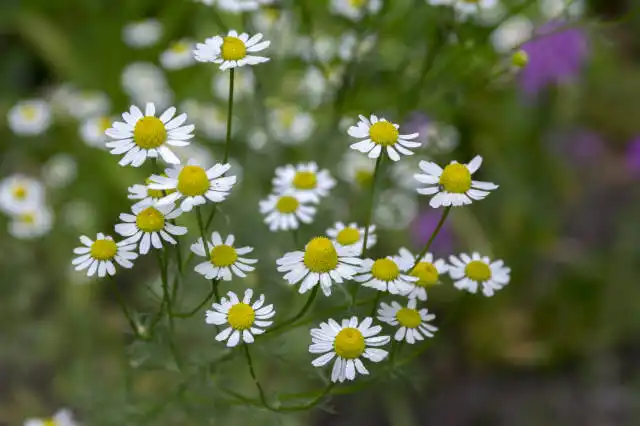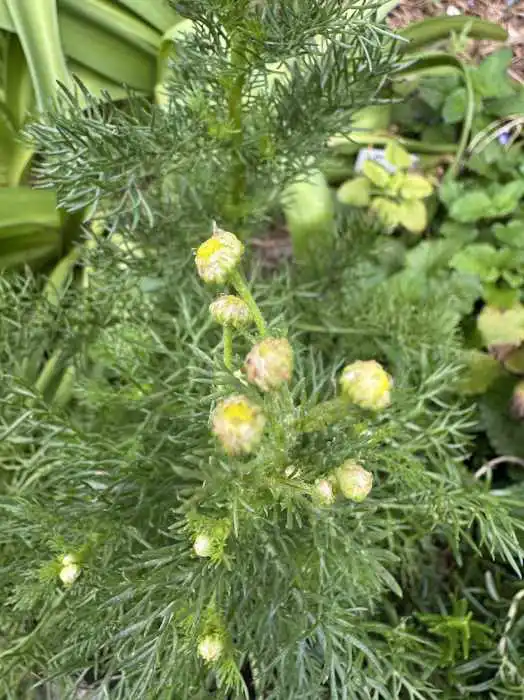One of the top medicinal herbs to grow is chamomile. The small white daisies are most commonly used in teas to reduce anxiety and aid in relaxation.
Chamomile is easy to grow and fragrant. Whether you’re planting to sip on some homemade chamomile tea, to attract beneficial pollinators or for your cut flower garden, chamomile will be a favorite in your garden.
This post may contain affiliate links. Please see my disclosure policies. If you purchase after clicking an affiliate link we may receive small commission at no cost to you. As an Amazon Associate I earn from qualifying purchases.
Types of Chamomile
There are two main types of chamomile: German Chamomile and Roman Chamomile.
Roman Chamomile
Chamaemelum nobile is a perennial. It’s shorter and works well as a ground cover. Roman chamomile has a stronger scent and popular in aromatherapy. This is a great variety for container gardening.
German Chamomile
Matricaria chamomilla is most commonly used for tea. It’s an annual plant, meaning it completes its life cycle in one growing season. German chamomile grows tall and produces lots of small, daisy-like flowers. It’s perfect if you’re looking to harvest flowers for teas or for cut flowers.
When and How to Plant Chamomile
In the low desert, December through April are great months to plant chamomile. Chamomile loves cool temperatures for germination. Ideally the temperature should between 60-70 degrees. It thrives in cooler temperatures. Once the temperatures near triple digits chamomile will stop blooming.
Chamomile seeds are tiny and need light to germinate, so don’t bury them too deep. Cover seeds very lightly and water regularly while waiting for germination.
How Fast Does Chamomile Grow?
Chamomile grows relatively quickly, making it perfect for impatient gardeners. After sowing, the seeds usually germinate within 7 to 14 days.
Once the seedlings sprout, they start growing rapidly. By about 8 to 10 weeks, your chamomile plants should be flowering and ready for their first harvest.
If you’re growing German chamomile (Matricaria chamomilla), it reaches a height of about 12 to 24 inches.
Roman chamomile (Chamaemelum nobile) grows more like a low, creeping ground cover, around 4 to 12 inches tall.
How to Care for Chamomile
Light Requirements: Chamomile likes 6-8 hours of sun and afternoon shade.
Soil Requirements: Prefers well-drained soil, however chamomile can grow in soil less than ideal as long as it has good drainage. Chamomile likes neutral and slightly acidic pH. The soil pH range of 6-7 is ideal.
Water Requirements: Chamomile is somewhat drought tolerant once established.
What Grows well near Chamomile and what doesn’t?
Chamomile’s strong aroma deters pests and its flowers attract beneficial insects like hoverflies and ladybugs.
It can enhances the essential oil production of basil, making it even more fragrant. It repels cabbage moths, making it a great companion for cabbages, broccoli, and cauliflower.
Harvest Chamomile- When is the ideal time to pick Chamomile?
You’ll know it’s time to harvest Chamomile when the white petals of the flowers begin to turn backward, and the center of the flower turns from flat to conical. Here’s how to do it:
- Use your fingers or a pair of scissors to snip off the flowers.
- Spread the flowers in a single layer on a mesh screen or a clean cloth in a well-ventilated, shady area. Allow them to air dry for about a week. Alternatively, you can use a dehydrator set to a low temperature.
- Once the flowers are fully dried, store them in an airtight container in a cool, dark place.
What is Chamomile Used For?
Chamomile is one of those wonder herbs with a wide range of uses. Here are some of the most popular:
Chamomile tea is famous for its calming effects, helping with sleep and digestion. Chamomile has anti-inflammatory and antioxidant properties, making it great for soothing irritated skin, treating eczema, and healing wounds.
It is often used in aromatherapy. The sweet, apple-like scent of chamomile is known to reduce stress and anxiety.
Chamomile seeds can be purchased at your local nursery, home improvement store or you can purchase chamomile seeds online.


